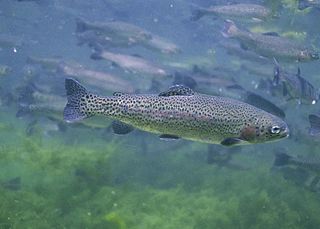
Trout is a generic common name for numerous species of carnivorous freshwater ray-finned fishes belonging to the genera Oncorhynchus, Salmo and Salvelinus, all of which are members of the subfamily Salmoninae in the family Salmonidae. The word trout is also used for some similar-shaped but non-salmonid fish, such as the spotted seatrout/speckled trout.

The rainbow trout is a species of trout native to cold-water tributaries of the Pacific Ocean in Asia and North America. The steelhead is an anadromous (sea-run) form of the coastal rainbow trout(O. m. irideus) or Columbia River redband trout (O. m. gairdneri) that usually returns to freshwater to spawn after living two to three years in the ocean. Freshwater forms that have been introduced into the Great Lakes and migrate into tributaries to spawn are also called steelhead.

The Californiagolden trout (Oncorhynchus aguabonita or Oncorhynchus mykiss aguabonita), is a species of trout native to California. The golden trout is normally found in the Golden Trout Creek, Volcano Creek, and the South Fork Kern River. The Golden trout is the official freshwater state fish of California since 1947.
Aeromonas veronii is a Gram-negative, rod-shaped bacterium found in fresh water and in association with animals. It can be a pathogen of humans and a beneficial symbiont of leeches. In humans A. veronii can cause diseases ranging from wound infections and diarrhea to sepsis in immunocompromised patients. Humans treated with medicinal leeches after vascular surgery can be at risk for infection from A. veronii and are commonly placed on prophylactic antibiotics. Most commonly ciprofloxacin is used but there have been reports of resistant strains leading to infection. In leeches, this bacterium is thought to function in the digestion of blood, provision of nutrients, or preventing other bacteria from growing.

The westslope cutthroat trout, also known as the black-spotted trout, common cutthroat trout and red-throated trout is a subspecies of the cutthroat trout and is a freshwater fish in the salmon family of order Salmoniformes. The cutthroat is the Montana state fish. This subspecies is a species of concern in its Montana and British Columbia ranges and is considered threatened in its native range in Alberta.

Streptococcus iniae is a species of Gram-positive, sphere-shaped bacterium belonging to the genus Streptococcus. Since its isolation from an Amazon freshwater dolphin in the 1970s, S. iniae has emerged as a leading fish pathogen in aquaculture operations worldwide, resulting in over US$100M in annual losses. Since its discovery, S. iniae infections have been reported in at least 27 species of cultured or wild fish from around the world. Freshwater and saltwater fish including tilapia, red drum, hybrid striped bass, and rainbow trout are among those susceptible to infection by S. iniae. Infections in fish manifest as meningoencephalitis, skin lesions, and septicemia.

Isopimaric acid (IPA) is a toxin which acts as a large conductance Ca2+-activated K+ channel (BK channel) opener.
Alkalihalobacillus alcalophilus is a Gram-positive, rod-shaped species of bacteria. Likely strains of this species have been isolated from highly alkaline waste water. A. alcalophilus is a moderate halotolerant obligate alkaliphile growing at 40 °C and at pH 9–10.5 that has been isolated from soil and animal manures.
Oceanobacillus iheyensis is a bacterium, the type species of its genus. It is a deep-sea species, having been isolated from a depth of 1,050 metres (3,440 ft), and is extremely halotolerant and alkaliphilic. Its type strain is HTE831. Oceanobacillus iheyensis HTE831 is an alkaliphilic and extremely halotolerant Bacillus-related species isolated from deep-sea sediment.
Oceanobacillus chironomi is a bacterium. It is Gram-positive, motile by peritrichous flagella, endospore-forming, halotolerant and facultatively alkaliphilic. The type strain is T3944DT.
Yersinia ruckeri is a species of Gram-negative bacteria, known for causing enteric redmouth disease in some species of fish. Strain 2396-61 is its type strain.
Weissella thailandensis is a species of Gram-positive bacteria. It is a homofermentative, sphere-shaped lactic acid bacteria. Its type strain is FS61-1T. Its genome has been sequenced.
Vagococcus salmoninarum is a species of bacteria, with type strain NCFB 2777. It is pathogenic towards Oncorhynchus mykiss.
Chryseobacterium lathyri is an bacterial species found in the rhizospheres of coastal sand dune plants. It is Gram-negative, non-spore-forming and non-motile. Its type strain is RBA2-6T.
Chryseobacterium oncorhynchi is a Gram-negative and rod-shaped bacteria from the genus Chryseobacterium which has been isolated from the trout Oncorhynchus mykiss.
Chryseobacterium shigense is a Gram-negative, strictly aerobic, rod-shaped and non-motile bacteria from the genus Chryseobacterium which has been isolated from a rainbow trout.
Chryseobacterium tructae is a Gram-negative and rod-shaped bacteria from the genus Chryseobacterium which has been isolated from the rainbow trout Oncorhynchus mykiss.
Tenacibaculum is a Gram-negative and motile bacterial genus from the family of Flavobacteriaceae.
Weissella ceti is a Gram-positive and non-spore-forming bacterium from the genus of Weissella which was first isolated from beaked whales. Erstwhile believed that W. ceti could cause hemorrhagic illness in Rainbow trouts, however, seems to be a different species from the same genus: Weissella tructae.
Flavobacterium chilense is a Gram-negative and non-endospore-forming bacterium from the genus of Flavobacterium which has been isolated from an external lesion from a rainbow trout from a fish farm in Chile.





